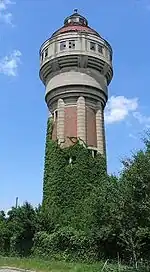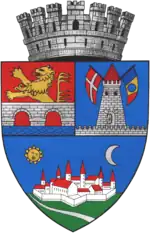| Fabric Water Tower | |
|---|---|
Turnul de apă din Fabric | |
 | |
| Alternative names | Fabric Water Castle |
| General information | |
| Status | Unused |
| Type | Water tower |
| Architectural style | Secession[1] |
| Location | Timișoara, Romania |
| Coordinates | 45°45′56″N 21°15′3″E / 45.76556°N 21.25083°E |
| Construction started | 1912 |
| Completed | 1914 |
| Height | 52 m[2] |
| Design and construction | |
| Architect(s) | János Lenarduzzi Richárd Sabathiel |
| Engineer | Stan Vidrighin |
The Fabric Water Tower (Romanian: Turnul de apă din Fabric) is an industrial monument in Timișoara, Romania. It was one of the sources of water supply in Timișoara at the beginning of the 20th century.[1] It is classified as a national heritage site (Romanian: monument istoric) with LMI code TM-II-m-A-06122.[3]
History

The first reference to a well dug inside the Huniade Castle dates back to 1551. Nevertheless, as Ottoman traveler Evliya Çelebi described, for a long time Timișoara has been supplied with water from the Bega River. The matter was also confirmed by Austrian traveler Henrik Ottendorf, who visited Timișoara in 1660 and later in 1663.[4][5]: 19–21
After the conquest of Timișoara by the Habsburgs in 1716, in 1729 the construction of an aqueduct began. It was supposed to bring water from Giarmata, but the plan was ultimately abandoned.[1] In 1732, a pumping station designed to pump water from Bega and filter it through several layers of sawdust was built on the site of the current Alexandru Sterca-Suluțiu Square in Fabric. In 1774, engineer Alexander Steinlein designed and built there a water tower to supply the city with water. It was destroyed during the 1849 siege; therefore the city was then supplied with water only from wells.[1][5]: 22–24
In 1891, after the demolition of Timișoara Fortress, the idea of a water supply and sewerage system resembling those in other European cities was set in motion and many projects were initiated, some of them, between 1904 and 1907, by Stan Vidrighin, mayor of Timișoara between 1919 and 1921 and from February to August 1922.[1] After researching the systems in Dresden, Berlin, Hamburg, Cologne, Strasbourg, Karlsruhe and London, engineers János Lenarduzzi (1865–1916) and Richárd Sabathiel (1875–1942)[6] executed a project countersigned by Stan Vidrighin, who had calculated the necessities and possibilities and had drawn up the task planner.[7][5]: 44–46 After the sewerage system had been finished and the waterworks had come into use, two towers were built at the two ends of the distribution network between 1912 and 1914,[8] which served to compensate for possible water outages in case of repairs or malfunctions.[5]: 44–46 The 52-meter high towers support a backup tank each, tanks that ensured the city's water supply for four hours, in case the central supply system would not have worked.[1]
After World War II, more water plants came into use and the towers were no longer necessary for their initial purpose.[9] Drinking water was provided by about 100 drilled wells,[10] which extracted water from 100 to 250 meters underground.[11] In the early 2000s, the Fabric Water Tower was given over by the Timișoara City Hall to 1 Iunie factory, a former local manufacturer of children's products.[12]
References
- 1 2 3 4 5 6 "Turnul de apă din Fabric". Timisoara-Info.ro.
- ↑ "Fabric Water Castle". Emporis. Archived from the original on 27 July 2018.
- ↑ "Lista monumentelor istorice din județul Timiș". Direcția Județeană pentru Cultură Timiș.
- ↑ Ottendorf, Henrik (2006). De la Viena la Timișoara, 1663. Timișoara: Banatul. ISBN 978-973-97121-7-0.
- 1 2 3 4 Vlaicu, Ilie; Hațegan, Ioan (2012). Alimentarea cu apă a Timișoarei: istorie, prezent și perspective (PDF). Timișoara: Brumar. ISBN 978-973-602-813-7.
- ↑ "Sabathiel Richárd". Magyar életrajzi lexikon 1000–1990. Magyar Elektronikus Könyvtár.
- ↑ Opriș, Mihai; Botescu, Mihai (2014). Arhitectura istorică din Timișoara. Timișoara: Tempus. p. 254. ISBN 978-973-1958-28-6.
- ↑ Opriș, Mihai (1987). Timișoara. Mică monografie urbanistică. Bucharest: Editura Tehnică. p. 148.
- ↑ Both, Ștefan (26 September 2016). "Turnurile de apă, cele mai înalte structuri din Timișoara, spații inedite pentru Capitala Culturală Europeană din 2021". Adevărul.
- ↑ Damian, Daniela (10 August 2015). "Încă zece fântâni publice în Timișoara. Zonele unde vor fi forate". Renașterea bănățeană.
- ↑ Ilaș, Gheorghe (18 June 2007). "Apă potabilă în fântânile Timișoarei". România liberă.
- ↑ Deaconescu, Roxana (19 September 2014). "Turnul de Apă din Fabric, un monument istoric al nimănui. Primăria Timișoara nu găsește actele prin care l-a dat în administrare". Opinia Timișoarei.
